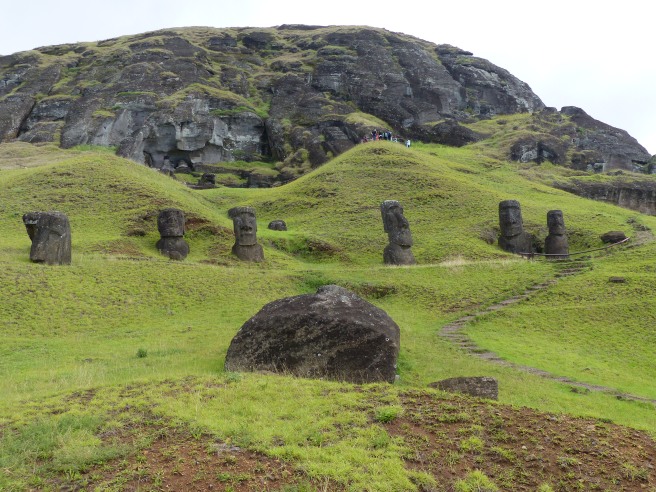
By Betty Gordon
© 2017 text and photos. All rights reserved.
In November 2016, spring in the Southern Hemisphere, I took an unforgettable, two-week trip to Easter Island and Chile. This is the third post about my adventures. See March 6 and February 12, 2017, for earlier posts.
“The statues in the quarries number altogether over 150. Amongst this mass of material there is no difficulty in tracing the course of the work. The surface of the rock, which will form the figure, has generally been laid bare before work upon it began, but occasionally the image was wrought lying partially under a canopy. In a few cases the stone has been roughed out into preliminary blocks, but this procedure is not universal, and seems to have been followed only where there was some doubt as to the quality of the material.”
— “The Mystery of Easter Island” by Katherine Routledge, published by Adventures Unlimited Press in 1919
Before Katherine Routledge’s expedition to Easter Island — embarked upon from Southampton, England, in a custom-built 90-foot schooner in February 1913 and completed in June 1915 — what was known about the moai (the images she refers to above) was largely down to a few visiting European or American ships in centuries previous, none of which stopped for very long.
Notations in personal diaries or ship’s logs were mostly made by crew members with little specialized scientific training, thus rendering their observations somewhat unreliable, though some fine illustrations of the moai are accurate likenesses.
No outsiders had ever immersed themselves longterm in the legends and oral histories of the island’s inhabitants, no one had made a full inventory of the number of stone figures in and out of the main quarry, and no one had spent many months roaming the landscape, studying the topography, taking photographs and making drawings.
In other words, Routledge’s “Mystery” was and remains a seminal work on everything Easter Island. Some of the conclusions she and husband William Scoresby Routledge made have been disproved or challenged, but they were the first to examine, document and theorize in depth about who likely carved the moai, how they did so and how the figures got from the quarries to their final resting spots atop ahu — ceremonial platforms — around the island.
Katherine often took the field lead, as when she delved into earlier inhabitants’ rituals and pre-missionary religion, spending hours listening to and recording on paper the remembrances of the few remaining elders with personal links to the past.
Routledge, a native of Darlington, England, attended Oxford University, enrolling in 1891 when she was 24. Her class choices and major were limited, as they were for all women. She read modern history (Americans would say majored in), but she was not a trained archaeologist or anthropologist, and neither was her husband, who did not complete his medical degree. She was not allowed to attain a degree at the time — they were not granted to women, even if they had fulfilled the requirements of their course of study.
She relied instead on her nearly inexhaustible curiosity and innate intelligence to make strides in understanding the people and places on the isolated island west of South America. When the Routledges’ self-funded Mana Expedition reached its destination after a year en route in March 1914, only about 250 inhabitants lived on Easter Island.
Katherine was in her late 40s. She spent nearly 17 uninterrupted months on the island — her husband sailed the Mana to Chile and back several times — and it was she who wrote up the voluminous notes about the expedition’s findings into a well-received book.
Easter Island, aka Rapa Nui, was likely settled by ancestor-worshipping Polynesians, who journeyed east from another island, traveling a distance of about 2,000 miles, possibly around A.D. 600 to 900, though no firm date has been established.
They believed that the moai captured an important clan member’s spiritual power or mana (the name of the Routledges’ schooner and expedition was no accident), and a statue would be commissioned to commemorate that person’s death.
Easter Island has no written history, other than the pictographs carved into rare wooden boards known as “kohau rongorongo.” Routledge was unable to find anyone who could translate the rongorongo, though she concluded through the elder interviews that the individual glyphs jogged a teller’s memory, an aid as it were, associated with a full story. To this day, a Rosetta stone for the tablets, few of which exist, has yet to be discovered.
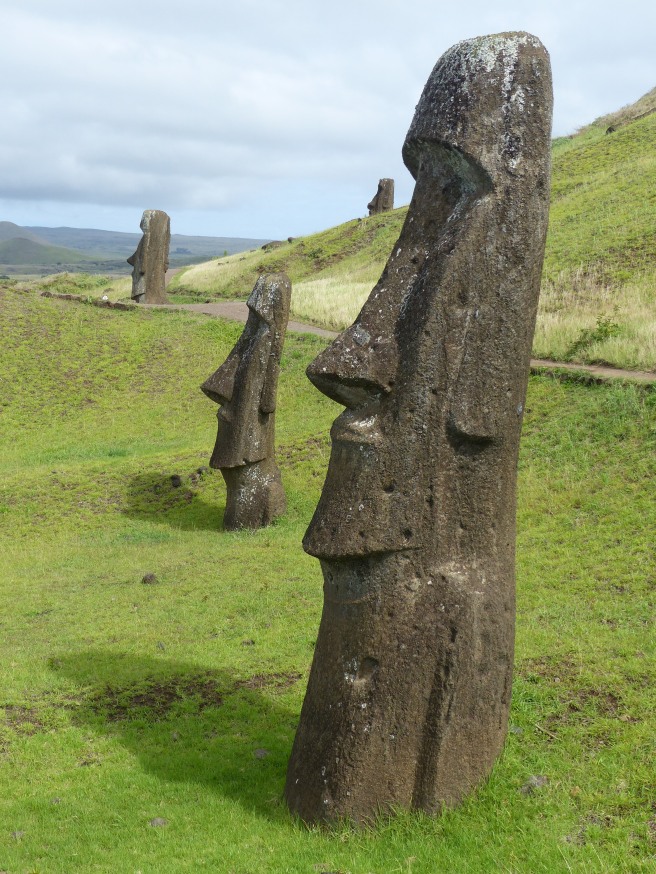
As for the 150 moai that Routledge cited in Rano Raraku, one of the island’s volcanoes, more recent anthropological excavations put the number at 397, with the figures being in various stages of completion or destruction. Some moai are as short as 6 feet; others top out at more than 26 feet. Most were likely constructed from about 1000 to 1600.
It’s simple to understand Routledge’s enchantment with the quarry, on the eastern side of the island. From every vantage point, there is something of interest to ponder, be it the off-kilter moai themselves, their positions on the grassy slopes, or the view east to the 15 moai at Ahu Tongariki and the Pacific beyond.
Of all the historical and cultural sites I toured, the greatest amount of time — about 2.5 hours — was spent in Rano Raraku, sometimes referred to as the “nursery,” because 95 percent of all the moai originated here. And though I enjoyed every minute of my time on Rapa Nui, the quarry is where my thoughts return to time and again.
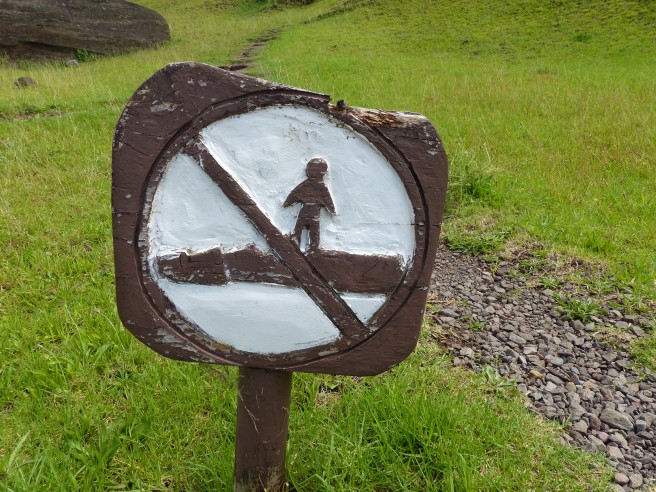
Of the moai that are upright, many are buried up to their necks or shoulders, exposing about one-third to one-quarter of the total height. The island’s carvers had to judge the proportions as they worked and keep in mind how to balance the weight and height so that the moai could stand when finished.
No easy feat for men who didn’t do mathematical calculations as we know them, and who were sculpting ever larger monuments. The most colossal of all the moai was more than 68 feet in length — its head being nearly 23 feet of that — and estimated to weigh 200 tons (or 400,000 pounds). It’s still attached on an exterior slope high up in the quarry.
Later expeditions using modern technology have identified a total of 887 stone figures around Easter Island, crafted from a hardened volcanic ash known as lapilli tuff. Only about 50 have been restored vertically atop ahu.
To complement the small team hired in England for the expedition and en route, the Routledges engaged local translators and workers to help in their field study. Laden with food, supplies and equipment, they took long walks or rode horseback to reach various sites, where they often camped for extended periods.
Scoresby Routledge hypothesized that a team of about 54 could carve a moai in less than 16 days. Later researchers think this was wildly optimistic, both in the size of the team and the speed of its work, if for no other reason than the steep slope of the quarry wouldn’t have allowed the workers the physical access Scoresby assumed.
A more realistic timetable would be up to two years to complete each moai. Generally, the figures were constructed lying on their back. Some were carved horizontally, some vertically, and some with the head pointing downward. This would indicate that the carvers made an assessment with regard to the suitability and width of the rock to be formed into the wide base.
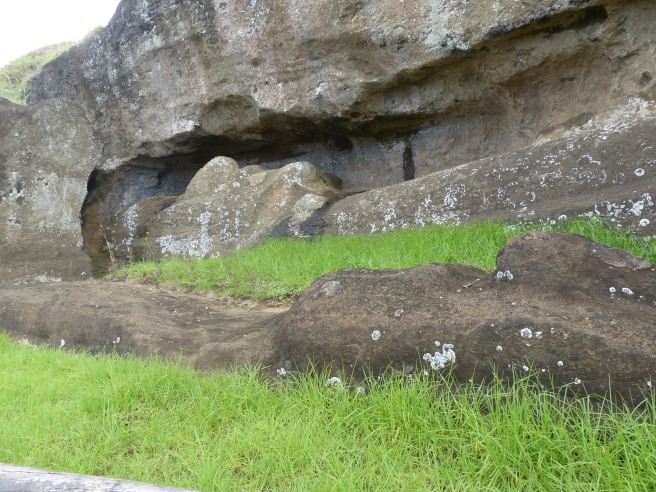
The elongated, oversized nose, heavy brows, lengthy torso, hands and arms (not all statues had these appendages, and they were delineations on the torso, not separate limbs), ears and closed lips were fashioned before the underlying stone was chipped away, like the keel of a ship.
Once freed, it’s believed the moai were pushed down earthen ramps — a pulley system also might have been involved — utilizing gravity and momentum to reach a prepared pit, where they could stand upright. (Pity the team if a moai broke apart at this or any other point. The figure would be abandoned, with many months of work for naught.)
Decorative carving could then be added to the back and the moai polished. Today, refinements are more noticeable on some moai than others, because not all figures were so decorated and natural erosion over the centuries has weathered them away.
“Mystery” includes photos of an alley or gutter surrounding incomplete moai, the space from which the workers accessed the statues. The varying amount of detail also suggests that as carvers’ skill evolved, so did the rendering of the facial features.
Only later, after their final transportation from the quarry and when the moai were positioned atop an ahu, were eye sockets completed. White coral (for the sclera) and red scoria (for the pupil) were inserted in a priestly ceremony. Thus “awakened,” their power was in full force. The eye socket discovery wasn’t made until 1978.
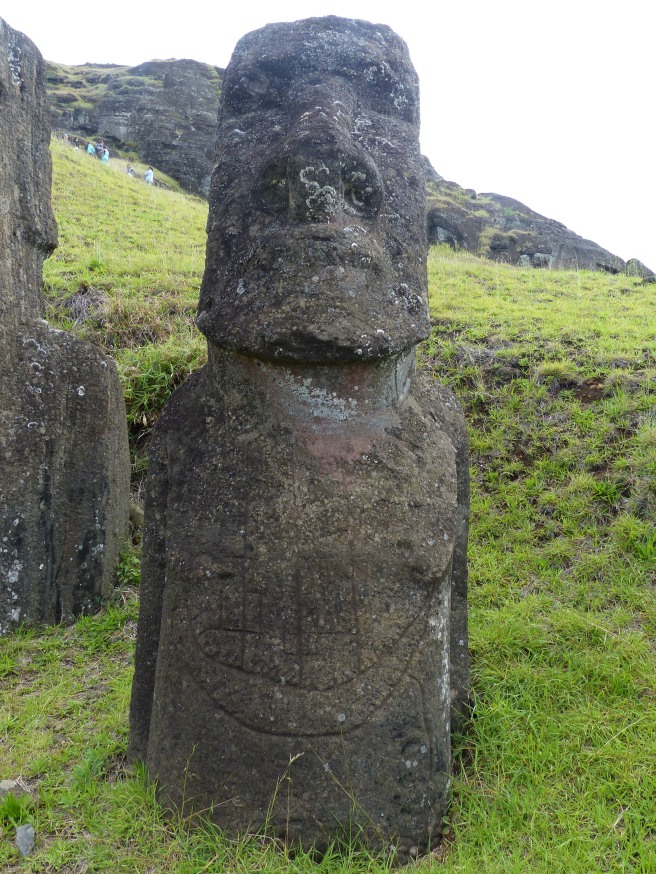
Quarry visitors will see on the torso of one of the unearthed moai a likeness of a three-masted ship, a commemoration, perhaps, of that islanders’ 18th-century interaction with European explorers.
Farther along the path to the right is a most unique moai, one that Katherine never saw. It was fully excavated in 1955 by Norwegian adventurer Thor Heyderdahl and his team. This figure is sitting on its legs folded under its body, its head is smaller and rounder than the other figures and its chin juts out instead of the vertical jawline of the other moai.
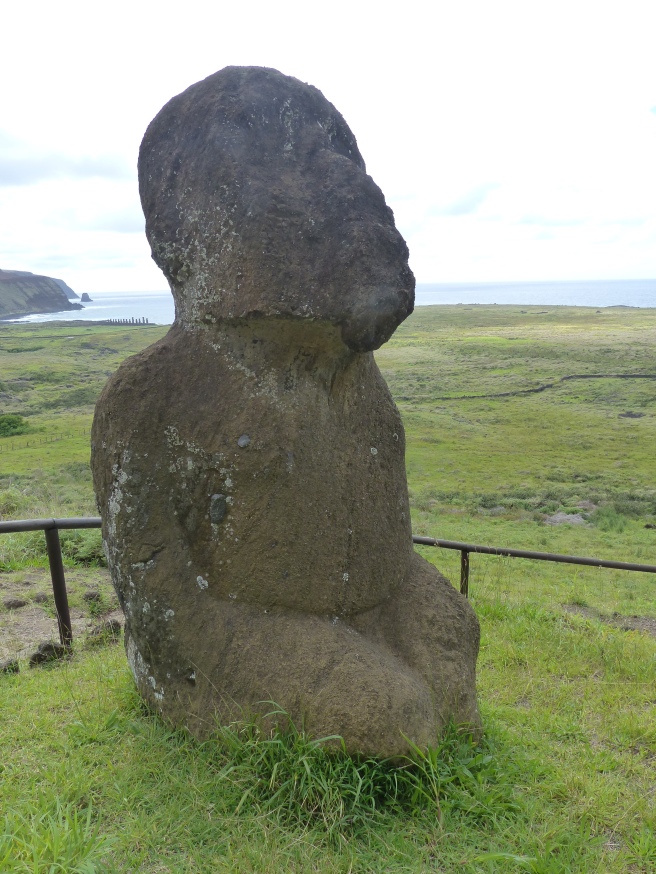
Why this moai, known as Tukuturi, which means “kneeling,” is so different from all the others is just one more of the enduring mysteries of Easter Island.
Quick reference: Many agencies offer daylong tours that include Rano Raraku. Peter, the co-owner of the bungalow where I stayed, Hare Swiss, booked for me with Mahinatur. 35,000 Chilean pesos, about $52. Multicourse, sit-down lunch was included. A hat, sunglasses, sunscreen and a water-repellant windbreaker are recommended. The next day, I did two half-day tours with the same company. The guides are multilingual. He or she will explain what you’re seeing in English and likely Spanish. Understandably, a lot of South Americans visit Easter Island. Here’s the website link; it’s in Spanish. http://mahinatur.cl/blog/
